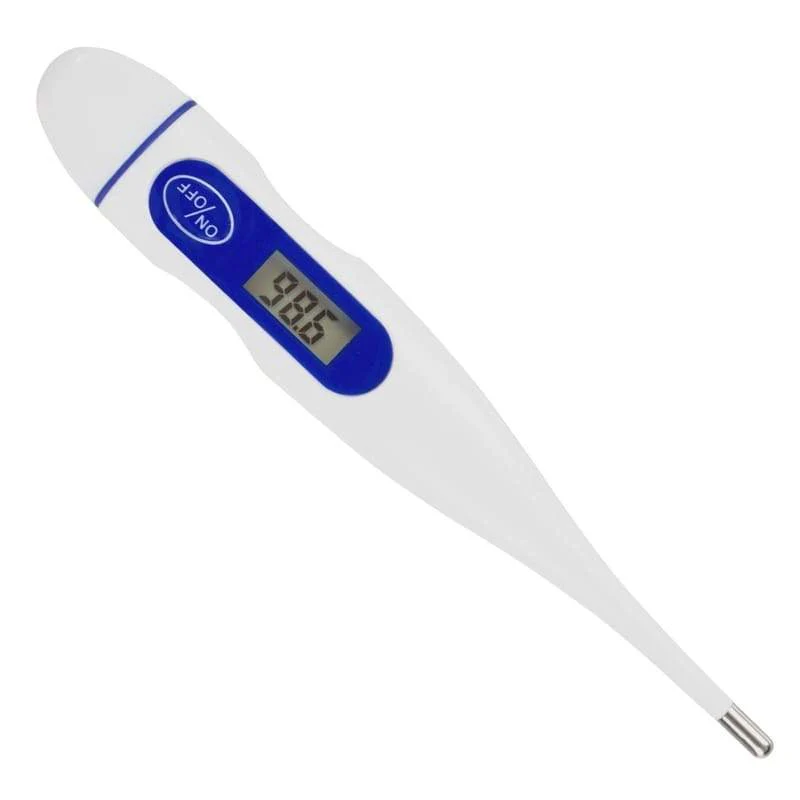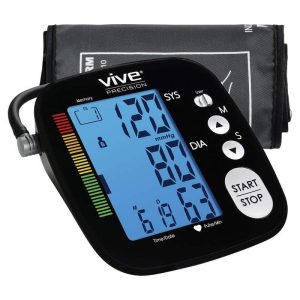A digital thermometer consists of:
- An LCD screen that displays temperature readings
- A temperature sensor (oral, rectal, underarm, or infrared)
- A power source (battery-operated) for portability
- A memory function to store previous readings (in some models)
Digital thermometers are available in different types, including oral, rectal, armpit (axillary), ear, and infrared (forehead) thermometers.
Key Features
✅ Fast & Accurate Readings – Results in seconds with high precision
✅ Safe & Mercury-Free – No risk of breakage or toxic exposure
✅ Multiple Measurement Modes – Oral, rectal, axillary, or infrared options
✅ Fever Alert Indicator – Beeps or changes color if fever is detected
✅ Memory Storage – Saves previous readings for tracking
✅ Automatic Shut-Off – Preserves battery life
✅ Easy-to-Read Display – Clear digital screen for quick results
Benefits of a Digital Thermometer
✔ Quick Temperature Measurement – Faster than traditional thermometers
✔ Hygienic & Easy to Clean – No risk of contamination with contactless models
✔ Ideal for All Ages – Suitable for infants, children, and adults
✔ Portable & Lightweight – Easy to carry for travel or daily use
✔ Clinically Accurate – Provides reliable readings for medical use
Types of Digital Thermometers
🔹 Oral Thermometer – Placed under the tongue, commonly used for adults
🔹 Rectal Thermometer – Provides the most accurate readings, recommended for infants
🔹 Axillary (Underarm) Thermometer – Less invasive but slightly less accurate
🔹 Ear (Tympanic) Thermometer – Uses infrared technology to measure eardrum temperature
🔹 Forehead (Infrared) Thermometer – Non-contact, ideal for quick readings in children and public settings
How to Use a Digital Thermometer Properly
- Turn on the thermometer and ensure it is clean.
- Place the sensor in the appropriate position (mouth, underarm, rectum, ear, or forehead).
- Wait for the beep or signal indicating the reading is complete.
- Check the temperature display on the screen.
- Clean the thermometer after use for hygiene.
Normal Body Temperature Range
✔ Oral: 97.6°F – 99.6°F (36.5°C – 37.5°C)
✔ Rectal: 98.1°F – 100.1°F (36.7°C – 37.8°C)
✔ Axillary (Underarm): 96.6°F – 98.6°F (35.9°C – 37°C)
✔ Ear & Forehead: 97.6°F – 99.6°F (36.5°C – 37.5°C)
Specifications
🔸 Measurement Range: 89.6°F – 109.4°F (32°C – 43°C)
🔸 Accuracy: ±0.1°C / ±0.2°F
🔸 Power Source: Battery-operated (replaceable or rechargeable)
🔸 Reading Time: 5-10 seconds (digital), 1-2 seconds (infrared)
🔸 Unit Display: °C or °F selectable
A digital thermometer is a must-have medical tool for fever detection and health monitoring. It offers fast, accurate, and safe temperature readings, making it ideal for home use, hospitals, and travel. With multiple types available, you can choose the best thermometer to fit your needs.
Frequently Asked Questions (FAQs)
1. What is a digital thermometer?
A digital thermometer is an electronic device that measures body temperature quickly and accurately using sensors instead of mercury. It provides a digital readout on a screen.
2. How does a digital thermometer work?
It uses heat-sensitive sensors to detect temperature changes and displays the reading on an LCD screen. Some models use infrared technology to measure temperature without contact.
3. What are the different types of digital thermometers?
✔ Oral Thermometer – Placed under the tongue
✔ Rectal Thermometer – Inserted gently into the rectum (most accurate for infants)
✔ Axillary (Underarm) Thermometer – Placed under the armpit (less accurate)
✔ Ear (Tympanic) Thermometer – Uses infrared to measure temperature in the ear
✔ Forehead (Infrared) Thermometer – Non-contact, scans temperature from the forehead
4. Which type of digital thermometer is most accurate?
Rectal thermometers are the most accurate, especially for infants. Oral, ear, and forehead thermometers also provide reliable readings when used correctly.
5. How do I use a digital thermometer correctly?
- Turn it on and place it in the appropriate position (mouth, underarm, rectum, ear, or forehead).
- Wait for the beep or signal indicating the reading is complete.
- Read the temperature on the display.
- Clean the thermometer after each use.
6. What is a normal body temperature reading?
✔ Oral: 97.6°F – 99.6°F (36.5°C – 37.5°C)
✔ Rectal: 98.1°F – 100.1°F (36.7°C – 37.8°C)
✔ Axillary (Underarm): 96.6°F – 98.6°F (35.9°C – 37°C)
✔ Ear & Forehead: 97.6°F – 99.6°F (36.5°C – 37.5°C)
7. Can a digital thermometer be used for both adults and children?
Yes! Digital thermometers are safe for all ages, but for infants, rectal thermometers are recommended for the most accurate reading.
8. How long does it take to get a temperature reading?
✔ Standard digital thermometers take 5-10 seconds
✔ Infrared thermometers provide results in 1-2 seconds
9. Can I use a digital thermometer on a sleeping child?
Yes! Forehead (infrared) and ear thermometers are best for checking temperature without waking them up.
10. Are digital thermometers accurate?
Yes, when used correctly, they provide highly accurate readings. Some models even include calibration settings to enhance precision.
11. How should I clean my digital thermometer?
✔ Use alcohol wipes or warm, soapy water to clean the probe after each use.
✔ Avoid submerging electronic parts in water.
12. Can I use the same thermometer for oral and rectal readings?
No! Always keep separate thermometers for oral and rectal use to prevent contamination.
13. How often should I replace the battery?
Most digital thermometers use replaceable button batteries that last several months to a year with regular use.
14. Why does my digital thermometer give different readings?
✔ Improper placement (not positioned correctly)
✔ Environmental factors (room temperature, sweating, or drafts)
✔ Low battery affecting accuracy
15. Where can I buy a digital thermometer?
Digital thermometers are available at pharmacies, online stores, and medical supply shops. Look for clinically validated models for the best accuracy.
Stay prepared—monitor your temperature with a reliable digital thermometer! 🌡️





Reviews
There are no reviews yet.